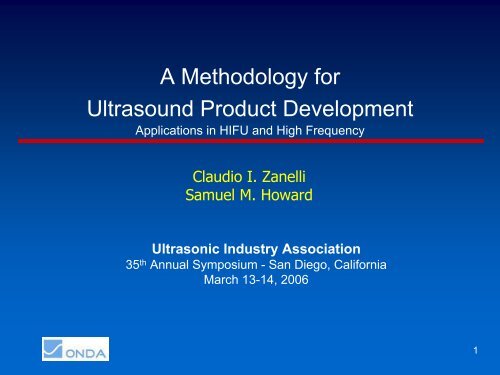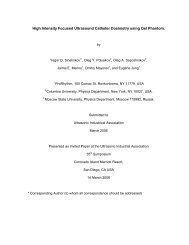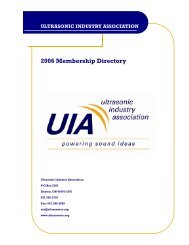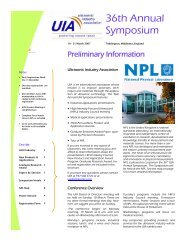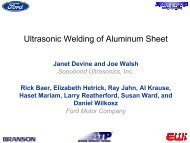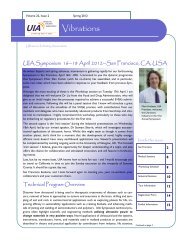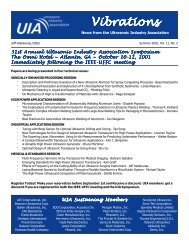A Methodology for Ultrasound Product Development - Ultrasonic ...
A Methodology for Ultrasound Product Development - Ultrasonic ...
A Methodology for Ultrasound Product Development - Ultrasonic ...
You also want an ePaper? Increase the reach of your titles
YUMPU automatically turns print PDFs into web optimized ePapers that Google loves.
A <strong>Methodology</strong> <strong>for</strong><br />
<strong>Ultrasound</strong> <strong>Product</strong> <strong>Development</strong><br />
Applications in HIFU and High Frequency<br />
Claudio I. Zanelli<br />
Samuel M. Howard<br />
<strong>Ultrasonic</strong> Industry Association<br />
35 th Annual Symposium - San Diego, Cali<strong>for</strong>nia<br />
March 13-14, 2006<br />
1
Outline<br />
• <strong>Ultrasound</strong> Medical Devices – the Challenges<br />
• Device <strong>Development</strong> Process<br />
• Outline of a Project<br />
• Case Study: HIFU <strong>for</strong> fat ablation<br />
• Case Study: High Frequency <strong>for</strong> Imaging<br />
• Case Study: Ranging Catheter<br />
• What we’ve learned - 3 lessons<br />
2
<strong>Ultrasound</strong> Medical Devices –<br />
the Challenges<br />
• Technology adoption by clinicians<br />
3
<strong>Ultrasound</strong> Medical Devices –<br />
the Challenges<br />
• Technology adoption by clinicians<br />
• Disposable vs. capital equipment<br />
4
<strong>Ultrasound</strong> Medical Devices –<br />
the Challenges<br />
• Technology adoption by clinicians<br />
• Disposable vs. capital equipment<br />
• The “Quick’n Dirty” catch<br />
5
<strong>Ultrasound</strong> Medical Devices –<br />
the Challenges<br />
• Technology adoption by clinicians<br />
• Disposable vs. capital equipment<br />
• The “Quick’n Dirty” catch<br />
• Reproducibility of results<br />
6
<strong>Ultrasound</strong> Medical Devices –<br />
the Challenges<br />
• Technology adoption by clinicians<br />
• Disposable vs. capital equipment<br />
• The “Quick’n Dirty” catch<br />
• Reproducibility of results<br />
• Other technologies: RF, drugs, MRI, video<br />
7
<strong>Ultrasound</strong> Medical Devices –<br />
the Challenges<br />
• Technology adoption by clinicians<br />
• Disposable vs. capital equipment<br />
• The “Quick’n Dirty” catch<br />
• Reproducibility of results<br />
• Other technologies: RF, drugs, MRI, video<br />
• Regulatory hurdles<br />
8
<strong>Ultrasound</strong> Medical Devices –<br />
the Challenges<br />
• Technology adoption by clinicians<br />
• Disposable vs. capital equipment<br />
• The “Quick’n Dirty” catch<br />
• Reproducibility of results<br />
• Other technologies: RF, drugs, MRI, video<br />
• Regulatory hurdles<br />
• The market, reimbursement, funding …<br />
9
<strong>Ultrasound</strong> Medical Device Challenges<br />
Adoption by Clinicians<br />
• No time to learn new tricks<br />
10
<strong>Ultrasound</strong> Medical Device Challenges<br />
Adoption by Clinicians<br />
• No time to learn new tricks<br />
• Minimal change from current procedure<br />
11
<strong>Ultrasound</strong> Medical Device Challenges<br />
Adoption by Clinicians<br />
• No time to learn new tricks<br />
• Minimal change from current procedure<br />
• Anything that will make it easier is OK<br />
12
<strong>Ultrasound</strong> Medical Device Challenges<br />
The “Quick’n Dirty” Catch<br />
Dilemma:<br />
1. Concept requires quick and cheap proof<br />
2. Build prototype – cheap. Undesirable features<br />
will be fixed later.<br />
3. Having prototype, do animal tests<br />
4. Go <strong>for</strong> FDA approval (510k or PMA)<br />
5. Go to production – any changes will require<br />
redoing animal tests <strong>for</strong> FDA.<br />
(Oops!)<br />
13
<strong>Ultrasound</strong> Medical Device Challenges<br />
Regulatory<br />
Fundamental<br />
• Bioeffects<br />
• Efficacy<br />
• Safety<br />
• Design Control<br />
• Process Control<br />
Bureaucratic<br />
• Documentation<br />
• Design Control<br />
• Process Control<br />
• PMA or 510k backup<br />
14
<strong>Development</strong> Project Outline<br />
Goal: Risk Reduction!<br />
• Lay out the ground work<br />
• Develop device and evaluate<br />
• File patents<br />
• Set up manufacturing<br />
• … wait <strong>for</strong> business success!<br />
15
<strong>Development</strong> Project<br />
Laying out the ground work<br />
• The IP landscape<br />
• The biology landscape<br />
• Modeling tools<br />
• Prototyping available<br />
• Measurements available<br />
• Technology landscape<br />
16
<strong>Development</strong> Project - Ground Work<br />
The IP Landscape<br />
• In<strong>for</strong>mation search<br />
• Patents database<br />
• Literature – journal articles<br />
• Awareness – networking<br />
• Legal determinations<br />
• Freedom to operate<br />
• Technology protection<br />
17
<strong>Development</strong> Project - Ground Work<br />
The Biology Landscape<br />
• Tissue properties<br />
• Acoustic<br />
• Thermal<br />
• Irreversible changes<br />
• Ranges of variations – model and human<br />
• Anatomical<br />
• Physiologic<br />
• In vitro vs. in vivo<br />
• Transferability across species<br />
• Animal model not available <strong>for</strong> all conditions<br />
• Diet matters<br />
• Size matters<br />
18
<strong>Development</strong> Project<br />
Project outline: Biology first and last<br />
1. Determine the effect sought<br />
2. Understand the tissue<br />
3. Model the interaction<br />
4. Design and model the beam<br />
5. Design the transducer and system (Des. Control)<br />
6. Test on repeatable (phantom) model<br />
7. Measure<br />
8. Iterate from 3 until confident with the physics<br />
9. Test in tissue<br />
10. Iterate from 2 until confident with the biology<br />
11. Test in humans<br />
12. Iterate from 2 until confident with the results<br />
19
Modeling Sound in Tissue<br />
• Experimental<br />
• Live and excised tissue are very different<br />
• Interceding tissue<br />
• Bone (e.g. <strong>for</strong> brain)<br />
• Fat<br />
• Muscle layers<br />
• Modeling issues<br />
• Non-linearity (KZK)<br />
• Acoustics affects thermal affects acoustics …<br />
• If heat matters, boundary conditions are key<br />
• Beam entrance<br />
• Perfusion<br />
20
Case Study: HIFU <strong>for</strong> Fat Ablation<br />
• Goal: Dissolve fat under skin<br />
• IP status: patentable<br />
• Biology: very complicated<br />
• Tissue: skin, fat, muscle<br />
• Success determined by heat, damage, resorption<br />
• Huge anatomical variability<br />
• Physics: Heat tissue to 50C, 4 seconds, 15-25 mm deep<br />
• Beam: F/1.2, 3 to 4 MHz, 30W max<br />
• Transducer: water standoff <strong>for</strong> coupling and cooling<br />
• Tests: phantom had to be developed<br />
21
Case Study: HIFU<br />
Transducer Modeled and Built<br />
22
Case Study: HIFU<br />
Location Problems<br />
23
Case Study: HIFU<br />
Tissue Modeling, Effects on Gel<br />
24
Case Study: HIFU<br />
Uni<strong>for</strong>mity Problems<br />
Picture of non-uni<strong>for</strong>m beam schlieren<br />
Picture of uni<strong>for</strong>m beam schlieren<br />
25
Case Study: HIFU<br />
Problem – Beam Entrance Heating<br />
26
Case Study: HIFU<br />
Surface Cooling<br />
27
Case Study: HIFU<br />
Transducers and Drivers - Prototype<br />
28
Case Study: HIFU<br />
Gel Burns<br />
29
Case Study: HIFU<br />
Gel Burns<br />
30
Case Study: HIFU<br />
Gel Burns<br />
31
Case Study: HIFU<br />
Gel Burns<br />
32
Case Study: HIFU<br />
Gel Burns<br />
33
Case Study: HIFU<br />
Gel Burns<br />
34
Case Study: HIFU<br />
Gel Burns<br />
35
Case Study: HIFU<br />
Gel Burns<br />
36
Case Study: HIFU<br />
Gel Burns<br />
37
Case Study: HIFU<br />
Gel Burns<br />
38
Case Study: HIFU<br />
Gel Burns<br />
39
Case Study: HIFU<br />
Conclusions<br />
• Tested in animal model<br />
• Raised $27M<br />
• Transferred <strong>for</strong> development in house<br />
• Evolved, about to market 4 years later<br />
40
Case Study: HF transducer <strong>for</strong> imaging<br />
• Goal: transducer <strong>for</strong> imaging at 30 um axial res.<br />
• Tissue: eye<br />
• Beam: F/2 25-45 MHz 3mm diameter<br />
• Transducer: water standoff <strong>for</strong> coupling<br />
• Tests: water echo<br />
41
Case Study: High Frequency Imaging<br />
Modeling the Transducer<br />
42
Case Study: High Frequency Imaging<br />
Generated Beam<br />
43
Case Study: High Frequency Imaging<br />
Transducer and Image<br />
44
Case Study: High Frequency Imaging<br />
Conclusions<br />
• Device improves over previous type<br />
• Funds unavailable<br />
• On hold<br />
45
Case Study: Ranging Catheter<br />
• Goal: transducer on a catheter <strong>for</strong> axial ranging, 250<br />
um axial res.<br />
• Tissue target: pericardium<br />
• Beam: defocused 12-15 MHz 2.5mm diameter<br />
• Transducer: direct contact with tissue<br />
• Tests:<br />
• Water is (acoustically) good enough<br />
• Animals, humans<br />
46
Case Study: Ranging Catheter<br />
Application<br />
47
Case Study: Ranging Catheter<br />
Application<br />
48
Case Study: Ranging Catheter<br />
Application<br />
49
Case Study: Ranging Catheter<br />
Application<br />
50
Case Study: Ranging Catheter<br />
Conclusions<br />
• “Enabling technology”<br />
• Successfully tested in humans<br />
• Company merged with its competitor<br />
• TMR technology fell in disfavor<br />
• <strong>Product</strong> cancelled<br />
51
What we’ve learned - 1<br />
• <strong>Ultrasound</strong> medical device development presents<br />
multifaceted challenges that need to be addressed in<br />
an integrated, multifaceted approach<br />
52
What we’ve learned - 1<br />
• <strong>Ultrasound</strong> medical device development presents<br />
multifaceted challenges that need to be addressed in<br />
an integrated, multifaceted approach<br />
Lesson:<br />
Follow a disciplined product development<br />
and integrate all the details.<br />
53
What we’ve learned - 2<br />
• A good medical device requires doing the homework,<br />
yet successful medical products are rare.<br />
54
What we’ve learned - 2<br />
• A good medical device requires doing the homework,<br />
yet successful medical products are rare.<br />
Lesson:<br />
Do not discount the cost of development<br />
based on speculation of future sales<br />
55
What we’ve learned - 3<br />
Medical device developers expect IP as part of the<br />
engineering work because IP is the most precious<br />
commodity, embodied in the engineering work.<br />
56
What we’ve learned - 3<br />
Medical device developers expect IP as part of the<br />
engineering work because IP is the most precious<br />
commodity, embodied in the engineering work.<br />
Lesson:<br />
IP is valuable, don’t give it away.<br />
57
Thank you !<br />
58


